If you’re building a new home or have an old septic system that is due to retire, you may be wondering how to install a septic system and asking the following questions: How much do new septic tank systems cost? Can I install a typical septic tank, or do I need a professional? Do state regulations (or the health department) allow me to install my own septic tank? What are the most common types of tanks? These are valid questions that can cause homeowners to feel overwhelmed when facing a new septic tank installation. We’re here to help reduce the stress and help you understand exactly what you need to get a new septic tank system installed that may need replacing.
What Is A Septic Tank?
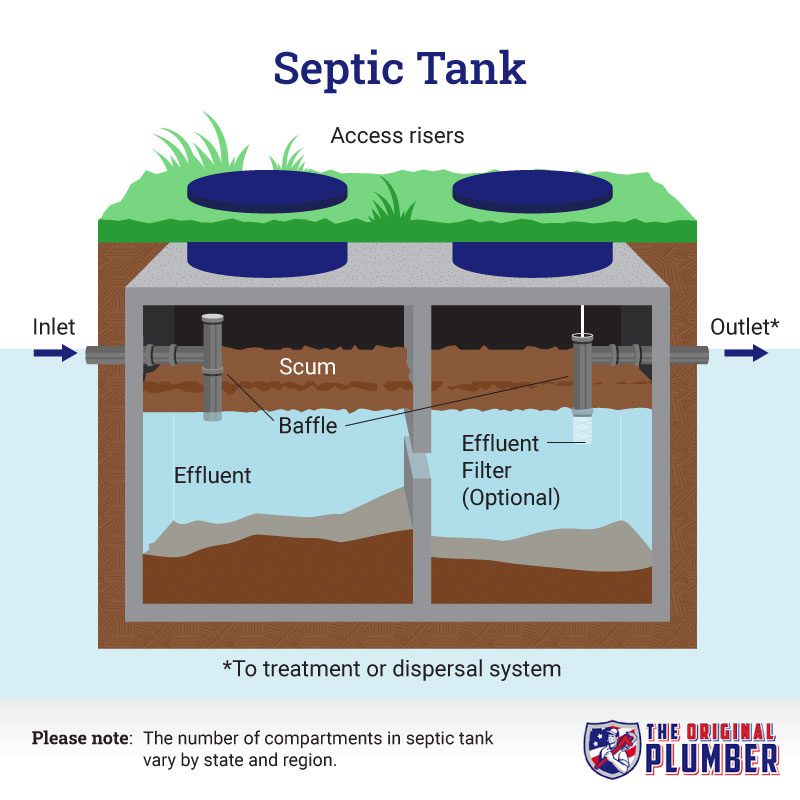 First, what is a septic tank, and why do you have one? Municipal sewer systems don’t serve every house, especially those in rural areas or homes that completed the construction process before a city or county system was in place. Homes that aren’t connected to a municipal option still need a way to process liquid waste flows like those that come from kitchen sinks, toilets, washing machines, and more. Septic tanks are alternative systems that treat household water and waste. Domestic wastewater flows from a home into the underground septic tank. The tank is typically made from concrete or plastic. All tanks use an organic process to reduce solid waste and separate it from the liquid waste, leaving the tank and entering the drain field, which will eventually filter through the soil. Septic tanks are an efficient system to treat wastewater, like a mini treatment facility in your backyard!
First, what is a septic tank, and why do you have one? Municipal sewer systems don’t serve every house, especially those in rural areas or homes that completed the construction process before a city or county system was in place. Homes that aren’t connected to a municipal option still need a way to process liquid waste flows like those that come from kitchen sinks, toilets, washing machines, and more. Septic tanks are alternative systems that treat household water and waste. Domestic wastewater flows from a home into the underground septic tank. The tank is typically made from concrete or plastic. All tanks use an organic process to reduce solid waste and separate it from the liquid waste, leaving the tank and entering the drain field, which will eventually filter through the soil. Septic tanks are an efficient system to treat wastewater, like a mini treatment facility in your backyard!
How Much Does A Septic Tank Installation Cost?
Having a septic tank installed requires more than just placing an order for a new system. Many factors go into choosing a tank and ultimately system costs. Below are a couple of things to consider when pricing a septic system installation.
Material Costs
Material choice can play a large part in the overall cost of installing a septic system. Concrete tanks are usually less expensive than alternative options. Plastic tank prices come next in line, and fiberglass options are typically the most costly, outside of a steel tank, which is less common. Tanks range from $800 on the small end to $2,000 on the higher end in most cases.
House and Gallon Size
The size of your house typically determines the septic tank size you need. The larger the house, the more occupancy and water use can be expected. A tank that is too small and is overwhelmed with too much water can experience severe problems, so choosing the right tank size for how much water will be used is critical.
Labor Costs
Labor costs often vary by geographical location and can be affected by the size of the tank and factors like the surrounding ground and soil. Heavy machinery or heavy equipment may be required for the installation, adding to the expense. Landscaping costs could also be a part of the project. While it is difficult to quote an exact price due to these factors and more, you can expect the average cost to be approximately $2,000 and, in some cases, closer to $5,000 and up.
Septic Tank Installation Process
Whether you plan to install the septic tank yourself or hire a professional, a few steps must be completed. Keep reading to learn more about each part of the process.
Research Permits and Talk to Local Government
Before any tank installation (a replacement system or a new install), it’s essential to talk to local authorities, including the local health department and health inspector. Installing your septic tank requires a septic permit and approval. If the septic tank is new, you may also have to complete a percolation test. A percolation test helps measure the soil and absorption rate. The results of a percolation test help guide the development of a new septic tank project. Before installing any systems, find out about your local regulations and any rules or guidelines that might impact your project. If you work with a reputable contractor, they will know about the local health districts and government guidelines. They can pull the necessary permits to complete your septic tank installation correctly.
Talk to Local Contractors
In some cases, specialized equipment is needed to install a tank. By talking with local contractors, you can get a quote for installation costs or better understand if you need a building permit, special equipment, a licensed electrician, and more before installation. If you are unsure about installing a septic tank yourself, this is also an excellent opportunity to request a quote. At The Original Plumber & Septic, our team is happy to conduct a free inspection on all types of septic tanks and the drain field and other components necessary to a septic system.
Digging Leach Field Trenches
Septic systems require a drain field or leach field. These soil absorption systems are trenches a few feet under the surface. The trenches are lined with gravel (or coarse sand) and include perforated pipes (or plastic chambers) that help distribute the wastewater. As the pipes slowly distribute the water, the water gets absorbed by the gravel and through the dirt. Understanding your soil type (bad soil, clean soil, coarse soil, sandy soil, etc.) and adequately digging the trenches for your perforated pipe (most often PVC pipe) is critical to the success of your conventional system. Different soil types, poor soil, or even factors like the local water table can impact the success of your septic tank, which is why installing your own tank is often not recommended.
Digging and placing the septic tank pit
Placing your septic tank is crucial to the success of your system. From plastic tanks to concrete tanks, septic systems require the right environment to continue to be effective year over year. Heavy equipment is often necessary to properly excavate the area for your tank and place it in the ground. Depending on the soil conditions, water table, and geographical landscape, you may need to dewater the area or add rocks and sand to ensure the ground is level and ready for the new septic tank. Most tanks are buried about eight feet down, so having specialized equipment needed on standby to place the tank and restore the area is advised. In some cases, a mound system may be required. This engineered drain field is different than traditional septic systems. It requires a different process for installation, which is another reason why working with a professional is recommended to ensure you get the right septic system installed for your needs.
What Size Septic Tank Do You Need?
The size of your house typically determines the size of your septic tank. A small two-bedroom home may be able to use a 1,000-gallon water tank, while a larger, 4-bedroom home or 5-bedroom home could require a tank that holds 3,000 gallons. In addition to the septic tank, you also need to have a corresponding leach field. Working with a professional like The Original Plumber & Septic will ensure you get the system installed that you need for your home size and property.
Types of Septic Tank Systems
In addition to tank sizes and materials, there are also different kinds of septic systems. Below are a few types and how they work to break down the solid waste and pump excess water out of the tank.
Mound Septic System
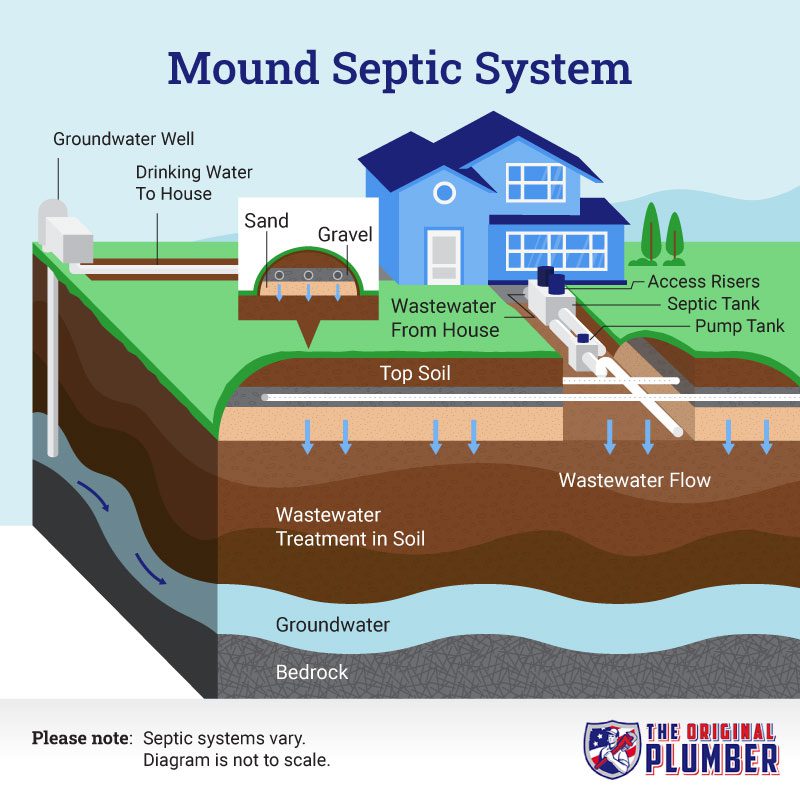
Anaerobic Septic System
Anaerobic systems are a common choice for homeowners. They use bacteria that can survive without oxygen, so they don’t require power or chemicals, unlike some other systems. The bacteria break down the solids, and the leftover water gets piped out.
Aerobic Systems
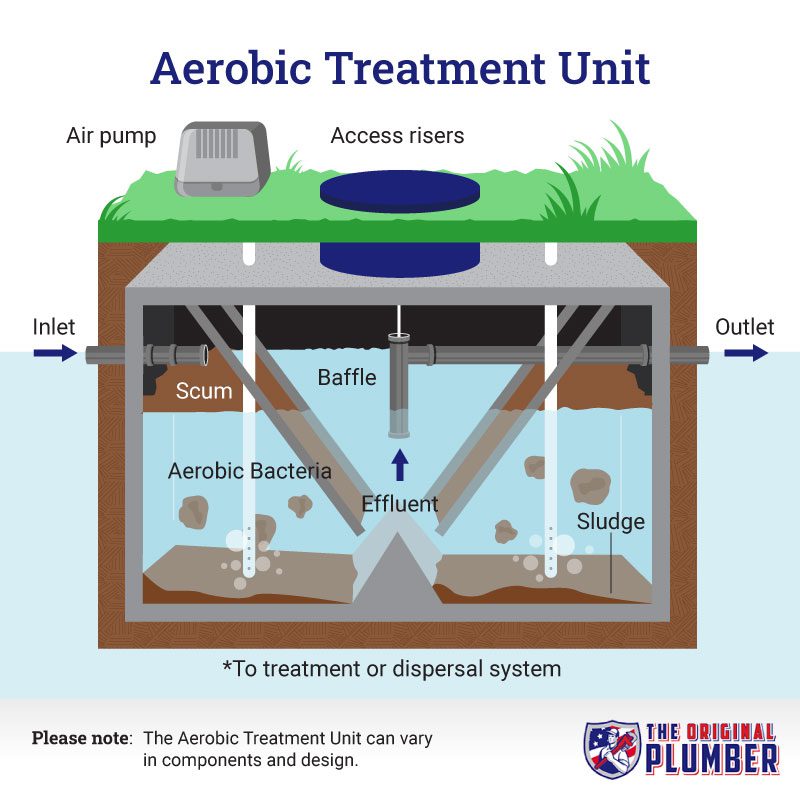
Conventional Septic System

Chamber Septic System
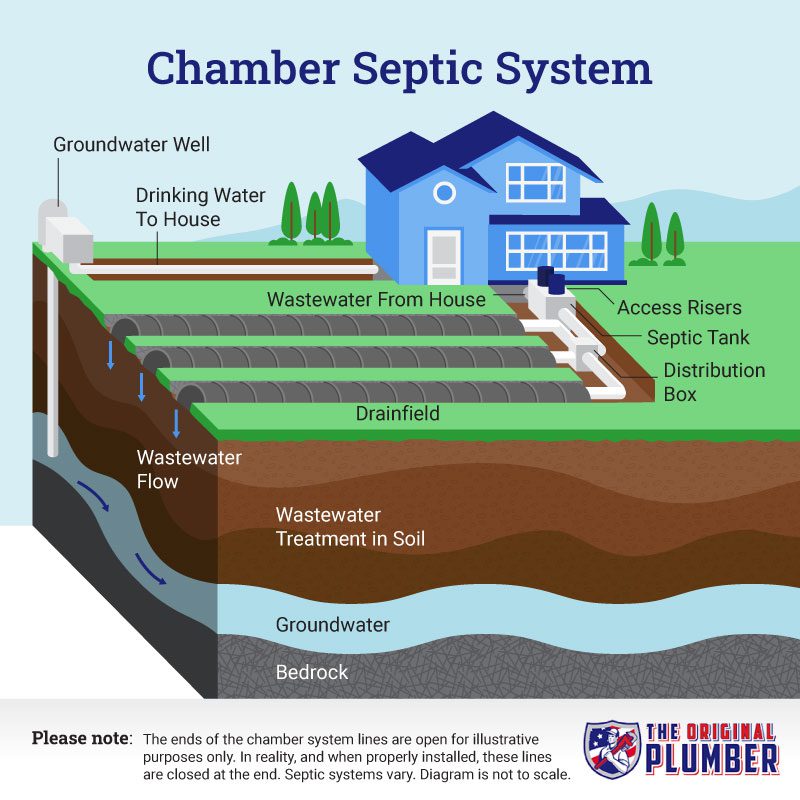
Gravity Septic System
As the name suggests, this option uses gravity for filtration and even water flow rather than a pump.
Septic Tank Materials
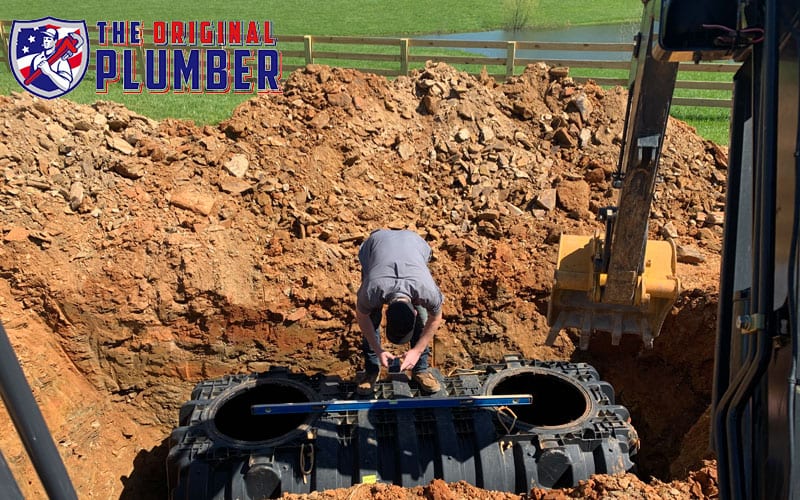
Concrete
Concrete is a solid option for septic tanks and is one of homeowners’ most common tank choices. When properly maintained, these tanks can last between 20 and 30 years. They’re also one of the lower or mid-range cost options. However; they are heavy, making installation more difficult. The tank may require reinforcement as cracks can occur if not properly placed.
Plastic & Fiberglass
Plastic tanks are lighter and easier to place on the ground. They also are on the cheaper side. On the con side, they can be more fragile than concrete or steel. Damage and cracks can quickly occur if driven over.
Steel
Steel is known for its strength, but it can quickly rust underground. If not properly maintained and cleaned, these options can collapse, causing some local governments to discourage this material for a new septic tank
Contact The Original Plumber & Septic
Whether you’re starting a new septic project or need to assess your current solution, we can help. Proper maintenance is necessary to ensure the longest possible life for your investment and avoid things like a clogged sewer or backup of sewage. Look for signs of trouble often and plan to have your tank pumped regularly. We have an experienced team of professionals and offer a complimentary assessment to walk you through actual project costs and installing a septic tank. Call (855) 761-3823 to schedule an appointment today!




